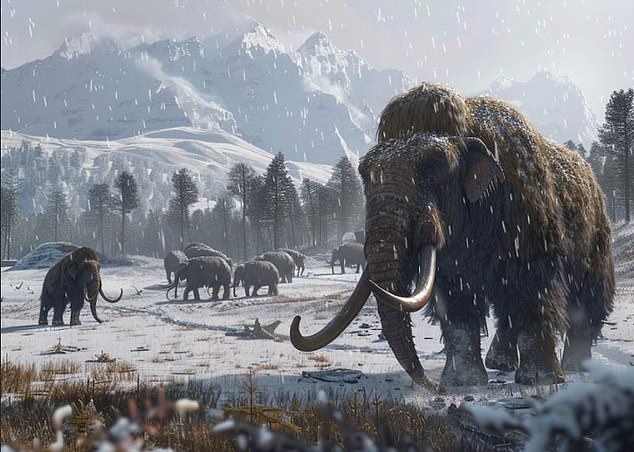Experts are one step closer to bringing the woolly mammoth back to life thanks to the first 3D reconstruction of chromosomes collected from ancient skin.
About 52,000 years ago, a woolly mammoth was freeze-dried by the weather just after it died, preserving its DNA in a glass-like state.
The unusually well-preserved specimen was excavated in northeastern Siberia in 2018, allowing a team of international scientists to analyze its skin tissue.
They have now successfully reconstructed the extinct species’ chromosomes – thread-like structures made of DNA.
This is the first time scientists have been able to do this from such an old sample.
Experts are one step closer to bringing the woolly mammoth back to life thanks to the first 3D reconstruction of chromosomes collected from ancient skin

About 52,000 years ago, a woolly mammoth was freeze-dried by the elements just after it died, preserving its DNA in a glass-like state. The exceptionally well-preserved specimen was excavated in northeastern Siberia in 2018, allowing a team of international scientists to analyse its skin tissue.
And they said this could boost efforts to “de-extinct” the woolly mammoth by allowing a DNA comparison with present-day elephants.
Currently, a company called Colossal Biosciences is leading the effort to bring the woolly mammoth back to life.
Their strategy is to take the genome of an Asian elephant and introduce a large number of small modifications into the DNA.
An Asian elephant will then carry that calf to term, giving birth to an elephant with many of the adaptations that made woolly mammoths thrive in the cold.
The team behind the new discovery says the genetic information preserved in this fossil is far more detailed than most ancient DNA fragments that have been found.
They were able to see not only which genes were present in the fossil, but also roughly which ones were on and which were “off,” something they had never seen before.
Erez Lieberman Aiden, one of the study’s authors from Baylor College of Medicine in Texas, said this will aid in efforts to de-extinct the mammoth by helping scientists understand what genes and sequences they need to “edit” in an elephant’s genome to turn it back into something resembling the extinct species.
“Like DNA, whole chromosomes have been thought of as fragile objects, unable to survive for long outside a living organism,” he said.

The study could boost efforts to “de-extinct” the woolly mammoth by allowing a comparison of its DNA with modern-day elephants.

The team that made the new discovery says the genetic information preserved in this fossil is far more detailed than most ancient DNA fragments ever found. Not only were they able to see which genes were present in the fossil, but also roughly which ones were on and which were “off” – something they had never seen before.
‘But under the right circumstances, chromosomes can, in fact, survive for a long time.
‘And this surprise makes many things possible, like assembling extinct genomes, or looking at the tissue of a woolly mammoth and seeing which genes were on and which were off, or examining the DNA loops that turn genes on and off.
‘The overall plan for de-extinction is to use what has been learned about the mammoth from DNA sequencing to engineer an elephantid life form that is similar, in important ways, to the mammoth.’
While versions of this plan have been around for some time, one potential obstacle was the large gaps in knowledge about the woolly mammoth genome (for example, how many pairs of chromosomes it has).
“The great news for de-extinction is that we don’t have to worry about whole sets of potential obstacles, because the overall structure of the two species’ genomes is quite similar,” Dr Aiden said.
“So it really looks like local[DNA]editing could take us a long way.”

“The great news for de-extinction is that we don’t have to worry about whole sets of potential obstacles, because the overall structure of the two species’ genomes is quite similar,” Dr Aiden said.
He said his discovery also helps determine exactly what edits are needed to transform an Asian elephant into a mammoth.
“For example, we can now look at the skin of the woolly mammoth and, using these fossil chromosomes, we can see, for the first time, which genes were active in the skin of a woolly mammoth that were not active in elephants, and vice versa,” he added.
‘We can now understand more deeply which genes and sequences we should focus on to make an elephant woolly and which sequences may be less important for that trait.’
Although the method used in this study relies on exceptionally well-preserved fossils, the researchers are optimistic that it could be used to study other ancient DNA specimens, such as Egyptian mummies.
Other authors include researchers from the University of Copenhagen, the National Centre for Genomic Analysis and the Centre for Genomic Regulation in Spain.
The findings were published in the journal Cell.


